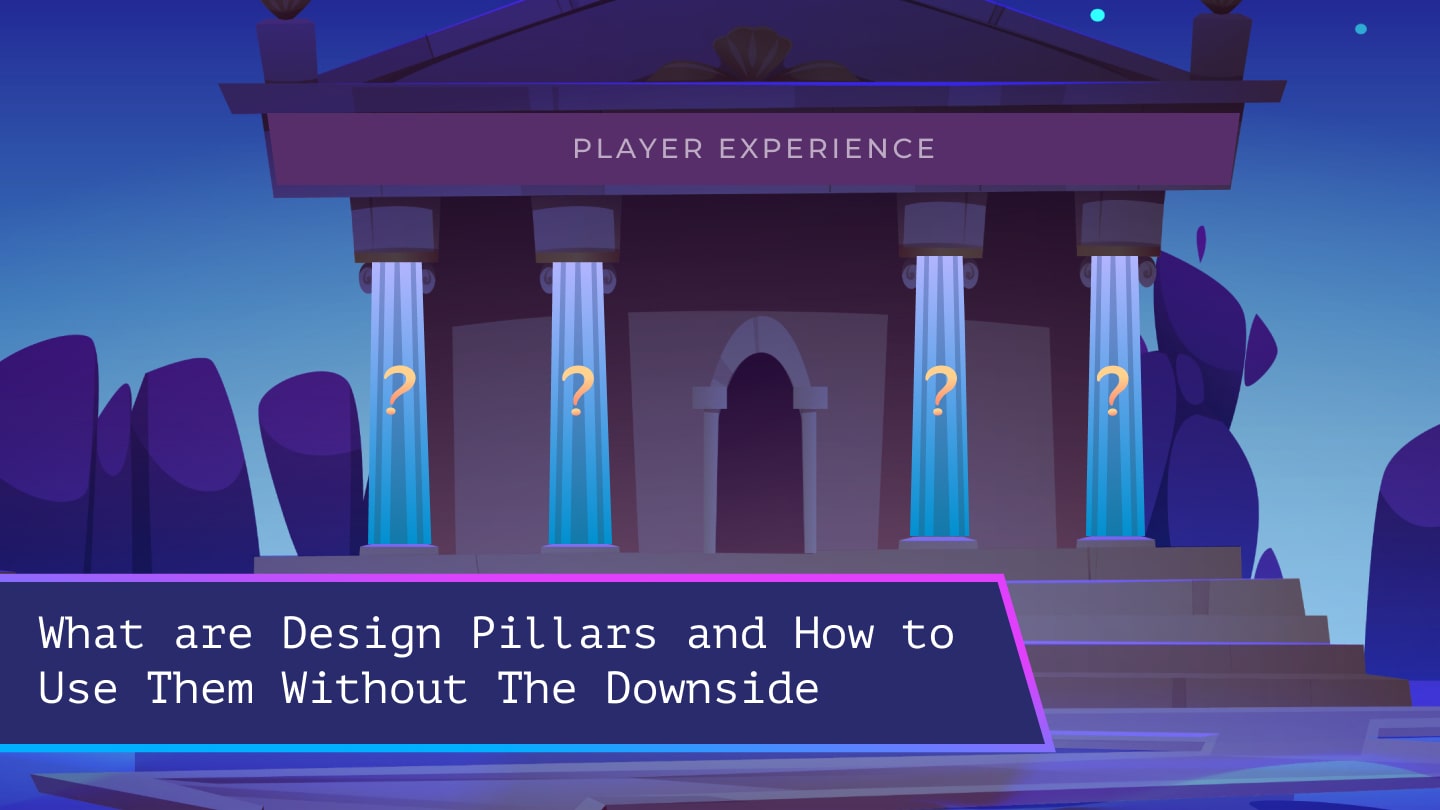In the past, game design documents would spiral out of control and no one would read them.
As a result, all the different people involved in development would have their own vision of the game, making conflicting choices about how to implement different parts.
Modern AAA Games tend to solve this problem by following an approach called design pillars. The creative director picks out distinct guiding principles for the game, and these serve as a guiding beacon for everyone below them.
By the way, as you read this post, feel free to join #career-guidance channel in Funsmith Club Discord where you can seek advice from game devs of all levels including me on
- Breaking into the industry
- Your resume/CV, Portfolio, design skill test, interviews, negotiations
- Navigating your current career path
You can also get notified each week on the latest game design job listings and actionable tips here 👇
What are Design Pillars?
Game design pillars (or “Game Pillars” or “Gameplay Pillars”) are a set of fundamental parameters that encapsulates the overall concept and direction of a video game. Once established, it orients the game studio’s entire development process towards one unifying vision to help their game development teammates with different backgrounds make complimentary design decisions.
But what design pillars actually look like can vary a lot.
Here are some real game design pillars examples used by AAA studios:
- Sony Santa Monica’s God of War design pillars:
- Combat
- Father & son
- Exploration
- Blizzard Entertainment’s Diablo 3 design pillars:
- Approachable
- Powerful heroes
- Highly customizable
- Great item game
- Endlessly replayable
- Strong setting
- Cooperative multiplayer
- Eidos-Montréal’s Deus Ex: Human Revolution design pillars:
- Combat
- Stealth
- Hacking
- Social
- Bungie’s Destiny design pillars:
- A world players want to be in
- A bunch of fun things to do
- Rewards players care about
- A new experience every night
- Shared with other people
- Enjoyable by all skill levels
- Enjoyable by the impatient and distracted
- Fallout’s design pillars (according to Tim Cain):
- Mega Level of Violence
- No Right Solution Player’s Action
- Affects the World and World Reacts to Player’s Actions
- Sense of Urgency
- Open-Ended
Pros and Cons of Using Design Pillars
There’s a lot of variation here, but let’s use God of War as an example, since it’s design pillars that are just the names of independent systems.
As I mentioned earlier, the vision for the game is players have intense combat, experience a father/son story, and explore the world.
Pros: This approach establishes the game’s structure and scope. Most AAA games include several types of gameplay with different intensities, which they weave together to create a sense of pacing.
In the case of God of War, its design pillars tell you what these components will be. Without them, the project could risk “feature creep,” gluing on more and more mechanics that lose focus and cause delays.
Cons: The trouble I’ve seen with design pillars is that they can promote an atomistic view of the game design.
When you orient your vision around discrete parts, you can end up designing for each part separately, instead of designing content that integrates all your game’s components.
For example, God of War design pillars could lead to a great combat system, an engaging world to explore, and a moving father and son narrative — but all designed by different teams in isolation.
There’s nothing in this vision that motivates game designers to think about the game as one complete whole.
So how do we address the limitations of the game pillar paradigm, at the same time, not fall into old chaotic ways?
Before we answer that, let’s first see what other game design approaches are available and how they work.
Functional vs Holistic Game Design
What is Functional Game Design (and Why It’s Problematic)
When applying design pillars, game developers make mechanics or game structure to directly meet a design goal or fulfill a need in the project.
I call this “functional design.”
However, focusing on the function creates a ‘tunnel-visioned’ frame of thinking resulting in a lack of integration with the broader set of game systems and mechanics. And the results are very static.
For example: If a character needs to do a specific thing, a mechanic or system is created to do that thing and that thing alone.
We see a lot of functional design in modern AAA games. It’s especially obvious when we compare reboots and sequels to much older games, made before the functional design / design pillar era.

Let’s examine how this translates in Doom and its 2016 reboot.
Comparing game levels:
| Doom (1993) – Original | Doom (2016) – Reboot | |
| Level Difference | Has levels where enemies, ammo, and powerups are placed within the level geometry to form a single challenge. | Has arenas that lock you into them and spawn enemies until a condition has been cleared. |
| Gameplay Result | Enemies physically blocked your path, creating an interesting choice between wasting limited ammo on them or trying to run past but risk being damaged. | You have an illusion of choice, where the decision is made for you, the rest of the level is segregated into its own gameplay (a scavenger hunt for collectibles). |
As you can see, the level design approach simply limits the players’ agency.
Comparing individual game mechanics:
| Doom (1993) – Original | Doom (2016) – Reboot | |
| Mechanics Difference | Has 1 combat system | Has 2 combat systems that work differently & independently:
|
| Gameplay Result | Melee attack was just another weapon you could wield. | Melee attack is now a contextual mini-cutscene, |
However, many of these reboots succeed at creating integrated holistic systems in other areas, even if there is a clear functional angle in how they designed some of their mechanics.
So giving credit where it’s due, Doom (2016)’s melee system might not be nuanced, but it still contributes to a successful game.
Even open-world games, marketed as a single huge environment for the player to interact with, can be plagued by functional design.
These shuttle the player between open world scavenger hunts, quests tracked with quest markers, and more linear missions that take place in handcrafted levels/scenarios.

Here are examples of games that do this as well
- Just Cause
- Prototype
- Infamous
- Nier: Automata
- Grand Theft Auto.
The world might be enormous, but you interact with it as a series of separate experiences, often in a constrained order.
Western vs Japanese Studios
Some of you just read that and thought:
“…But what about Elden Ring?”
“What about Breath of the Wild?”
These two celebrated open-world games have a less clear delineation between the open world and specific content.
You’re free to ignore Elden Ring’s main dungeons, explore anywhere you like, and come back later.
Not coincidentally, both of these games were made by Japanese studios. Most of these, as well as smaller-budget studios everywhere, don’t seem to use design pillars or functional design.
You can also see this difference in individual game mechanics.
Western AAA games: Many abilities do the same limited, very specific function they are designed for, and do nothing else when a button is pressed, which is very static.
For example: Deus Ex: Human Revolution’s takedowns or Typhoon ability.
Japanese AAA games: Uses “multiplicative design” approach to create as many interactions between different game elements as possible.
For example: In Breath of the Wild, they created a “Chemistry Engine” system that categorizes objects by material (wood, metal, stone), and allows elements (fire, wind, electricity) to take effect on them.
Instead of using limited, defined interaction points, many abilities are physics-based. The distance, timing, aim, and type of material all add nuance to the end result.
Here is the Breath of the Wild developers’s breakdown of this paradigm:
They were so focused on this holistic style of game design, they didn’t include an option to pet the dogs that roam around in-game.
They stated:
[bctt tweet=”In terms of design philosophy, it just didn’t fit with how we actually made the game world. It’s actually more about taking a smaller number of actions and using them in as many ways as possible. – BOTW Devs” via=”no”]
This approach allows for a range of possible outcomes based on variance in the player’s input, instead of using the paired animations or snap-to-point mechanics common in the West.
So what design philosophy is behind this approach?
Because of the language gap, it’s difficult for me to know Japanese developmental methodologies in detail. But from what I’ve read, Japanese productions tend to have design work sit primarily with the director of a game.
Even in the west, we often know the names of directors for successful games, such as
- Shigeru Miyamoto
- Hideo Kojima
- Hidetaka Miyazaki
- Hideki Kamiya
- Shinji Mikami
- and so on
We tend to know the names of even less prestigious Japanese directors, such as
- Keiji Inafune
- Hideaki Itsuno
- Yoshiaki Koizuimi
- Tomonobu Itagaki
- Kamone Serizawa
- Yoko Taro
Part of this might be due to the way our fan communities work, but directors do seem to have a strong influence on their respective games.
(Here are my thoughts on how Platinum Games’s quality depends on who directed that title.)
Another design role in many Japanese studios is the “planner,” who carries out their work by very directly assigning specific people specific tasks.
For example: Woshige Ogawa was Street Fighter V’s Battle Planner, and was given a lot of responsibility over that game’s battle system, while Yoshinori Ono was more of a lead for the overall direction of the game.
Given this is the case, it seems unlikely that Japanese productions follow a design pillar development methodology, or that the people involved in Japanese game development contribute as much to the design of the game as the director or planner.
In this approach the game’s overall vision is concentrated in the hands of a few people, and other designers have less input through implementation decisions compared to most Western studios. This creates less need for design pillars, which exist to orient large teams of people around common goals.
Perhaps another unifying factor for Japanese game design is that the way games are pitched tends to be very brief and mechanics focused, where a lot of western pitches are very broad and setting/story focused.
Japanese designers tend to pitch games with a focus on mechanics and a lot of supporting details for how the game will be assembled.
The West trends towards shorter pitches that are focused on narrative.
Holistic Design, or How to Fix This Problem in Western Design

I prefer to approach game design holistically instead. This means I treat all the game’s components as interlocking pieces of a single whole. Even if I’m only responsible for designing a single system, I prioritize its connections with other elements.
This ties into my “theory of depth” in game design, which I’ve written a lot about in other blog posts. In a nutshell, depth is created by nuance within mechanics (how many input-dependent outputs they create), and by interactions between mechanics and systems. The more balanced, relevant game states exist, the deeper a game is.
In a practical sense, this is fun because it means there’s a wider variety of things that can happen, so players get bored less quickly. It also means there are a lot of skills to master, so players get less stuck if they have trouble with a particular skill, and have new skills to learn when they master one.
Not only do I think this holistic design approach leads to more engaging games, it’s a more efficient use of game studio resources to develop a few mechanics that accomplish many things instead of a great number that each accomplish only one thing.
If you are designing different sets of mechanics that are segregated from one another, you effectively need to build multiple games, each with enough interlocking elements to independently create depth.
For example: A game with a driving minigame, a combat minigame, and a stealth minigame takes three times as much work as a game that does just one of those really well.
Holistic design also makes individual mechanics deeper and more engaging. The early Assassin’s Creed games approached combat by creating paired animations for attacking, countering, and other abilities. Each mechanic was tailor-made for a specific situation; combat consists of learning when to choose the correct option.
But, going against the Western trend towards functional design, the Assassin’s Creed team eventually pivoted to detailed hit-boxes. This opened up the possibility of attacks being interrupted based on range, speed, or timing. Different moves have trade-offs and flexibility, creating interesting choices.
Functional Design Example: Deus Ex: Human Revolution (DX:HR)
Before I critique some games, I want to mention that design pillars are about how the game was actually made. Think of them in a similar light to the Waterfall, Spiral, and Agile development methodologies. They are not critical lenses for analyzing any game.
Without hearing from the developers themselves, I can’t say for sure what their exact design pillars are, or even if they used design pillars.
Trying to apply design pillars to a game post-hoc is a Rorschach test of what the observer thinks is a design pillar, rather than a structurally identifiable truth about the work.
But we do know the broad design pillars used in Deus Ex: HR specifically, and can still critically examine its mechanics from the perspective of functional versus holistic design.

In Deus Ex: Human Revolution, the design pillars are
- Combat
- Stealth
- Hacking
- Social.
To that end we see these modes of play as very segregated from one another.
The augmentations in DX:HR tend to trigger cutscenes and consume energy in one-bar increments, such as
- Takedowns
- Icarus
- Wall punching
- Typhoon
Let’s analyze the how the design approaches between Deus Ex: Original vs Deus Ex: HR translate into gameplay.
Comparison 1:
| Deus Ex: Original | Deus Ex: HR | |
| Difference | The system has more nuanced solutions that have
|
Most augmentations bypass obstacles in a very binary (pass or fail) and functional way. |
| Example | The electric prod could knock out enemies if it was used on their back while they were unaware. | The takedown button was just a generic contextual use button on enemies. |
Comparison 2:
| Deus Ex: Original | Deus Ex: HR | |
| Difference | Has many different “keys” to unlock the same obstacle gating your path.
(the players can solve the same problem with the same augmentation) |
Has a bunch of different obstacles that each accepts a different “key.”
(The players needs to solve each problem with a different augmentation) |
| Example | Player can get past a door by
|
For example:
|
(To DX:HR’s credit, some obstacles do occasionally have more than 1 solution. For example, some ledges can be reached by jumping, moving crates by a strength aug, or bypassing through the ever-present vents. But overall much more static than the original)
The overarching gameplay result: There is less room for creativity in Deus Ex:HR compared to Deus Ex Original
While I think DX:HR is a better game, because it succeeds more at its core gameplay styles of combat and stealth than the original did, the original Deus Ex certainly represents a mechanical design holism that we don’t really see in DX:HR when it comes to progressing through levels.
By the way, for those wondering, yes, this article was inspired by Hbomberguy’s DXHR video:
Holistic Design Example: Crysis Warhead
A good example of design holism for comparison to Deus Ex Human Revolution is Crysis Warhead. (And the original Crysis to a smaller extent, but I’ll be focusing on Warhead.)
Crysis Warhead also focuses on Combat and Stealth, and shares a lot of the same core mechanics as well, such as using your nanosuit to power up your combat, jumps, speed, and stealth. Like DXHR, Crysis Warhead is designed with levels that suit both combat and stealth.
The critical difference is that the Crysis Warhead AI does not know where the player is after they disappear behind cover, and cannot track an invisible player until they do something to reveal themselves. So any time you disappear behind cover, you could go invisible, run behind the enemy, and shoot at them from another angle.
This means that Crysis Warhead is capable of mixing stealth and action gameplay in a way that Human Revolution usually doesn’t. In Human Revolution, stealth and combat are usually segregated from one another, and messing up stealth means you’re stuck in combat. (Or more realistically, that you reload a save.)

See How You Can Learn the Gameplay Design Abilities Game Studios Are After To...
- Get more interview invites & job offers
- Replicate decisions that make games fun
- Learn faster with mentorship guidance
In Crysis Warhead, stealth and combat blend together fluidly into one cohesive system. (This is also true of Far Cry games, which share some of the same engine and AI code.)
Some more differences in Crysis Warhead’s implementation are that you can regenerate your entire bar for invisibility; silent walking isn’t a separate power that causes your energy to drain at a faster rate; levels tend to be outdoor areas filled with cover objects; and enemies don’t get stuck in alert mode (so you don’t have the same incentive to reload).
Admittedly, there is also some difference in direction. Crysis isn’t really a pure stealth game like DXHR can be treated. You can’t bypass every encounter undetected, and at times you do need to fight enemies, so you don’t have the same pressure to do a ghost playthrough as with DXHR.
Additionally, you don’t really have many options to silently dispatch enemies (you could strength punch them, but you’re likely to end up noticed by other enemies anyway). When you’re completely undetected, Crysis Warhead tends to treat this as a way of planning your direction of attack, rather than a goal in-of itself.
Unsurprisingly, the Crysis team didn’t use the design pillar approach that can lead to functional design. Instead, they had more of a design vision of player freedom and “wide linear” levels. Their approach to the original Crysis was more disorganized, and then Warhead was a response to many of the criticisms of the original game, built in the same engine, with the advantage of hindsight.
Crysis Warhead had a holistic view of all the mechanics they created. The team wanted to let players engage with any of them at any time, rather than present an atomized view of individual mechanics and give each of them a place to shine like DXHR’s functional design did.
Combining Design Pillars with Holistic Design
Design pillars are a functional approach to creating a coherent final product, but they can’t replace foundational game design principles, which need to inform the implementation of those pillars.
So the next iteration is to combine the two:
- The practicality of design pillars for keeping a team oriented around a common vision
- Holistic design ability that integrates pillars into a cohesive whole.
A great example of this two-pronged approach is applied by Paradox Games across their different games.
Their use of design pillars doesn’t include specific segments of the game design, instead focusing on core values that are meant to be shared across the design.

Paradox Games are typically city builder games with tight system integration (admittedly not my genre, but I can see the appeal).
If pillars are meant to filter new ideas and team decisions, then pillars focused on the specific articulable values of a game might be a better way.
Destiny and Diablo 3 both had poorly received initial releases, and you’ll notice their design pillars (also listed earlier) are a lot less specific and value-oriented than Paradox’s.
They contain features rather than values, and they’re fairly generic feature sets which almost any game would want to live up to.
They establish a vision for a specific game, then filter it through their studio’s values for what one of their games should be, instead of segregating the game idea itself into different modes of gameplay then working on them separately.
This is reflected in Paradox games, which tend to be about developing a civilization by means of complex, interlinked resource economies. Everything in their games feeds back into this system of relationships, rather than diverging off into minigames or alternative game modes.
Refining Pillars from Begone Beast
Pillars are not always set in stone. Sometimes you will discover certain elements are more valuable than others. If you have too many pillars, they can make it more difficulty for others to figure out which elements to prioritize.

Begone Beast by Tandemi started out with a lot of pillars. The founders found these extremely helpful in expressing the soul of the game they wanted to create. However, over time they refined it down from:

To Just:
- Emergent Pickles: The specific emergent gameplay type where players are getting into and out of pickles (tricky situations) in surprising and unique ways
- Co-opportunities: Player and Monster actions create opportunities for allies to easily capitalize on
- Spooky Adventure: Sessions are a climactic journey with a theme/tone perfect for Halloween
By focusing on these three essential elements, it was easier to help guide the rest of the team to the kind of content that was best for their game!
Final Thoughts…
I’d like to see future western AAA games approach their mechanical design more holistically, trying to connect as many elements to as many other elements as possible, instead of segmenting the game into different modes of play.
However it’s unlikely that these established western studios are going to adopt a Japanese model of directorial control.
This is where the opportunities open for the new up and coming studios.
At the end of the day, it’s the market that determines the winners.
Feel free to share below if you have any questions or comments. 👇












